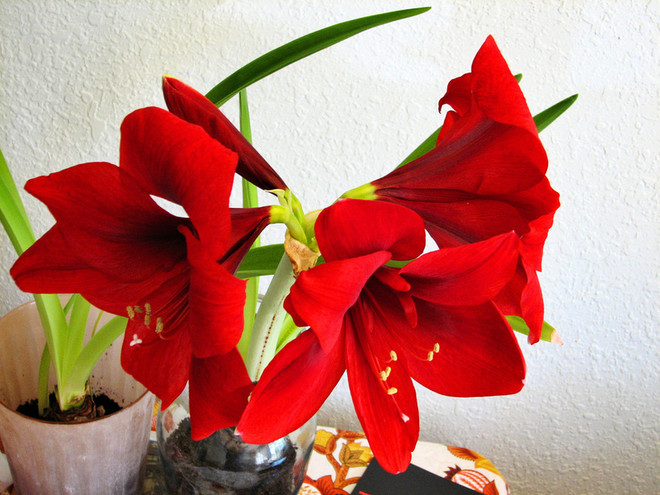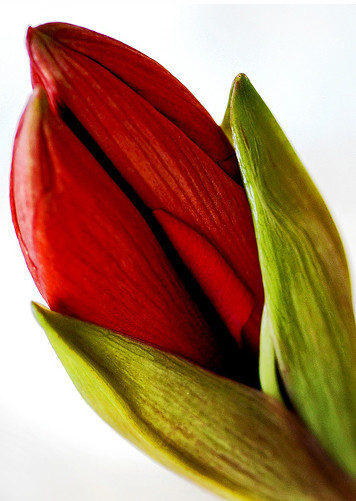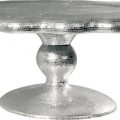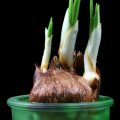 Hippeastrum at homeHugeThe six-petaled "stars" of the hippeastrum (Hippeastrum hybrida) bloom on Christmas Eve. This flower is sometimes mistakenly called amaryllis (Amaryllis belladonna). Indeed, they are similar, but the hippeastrum has 3-6 flowers in an inflorescence, while the amaryllis has 6-12. And amaryllis blooms in the fall, not in the winter, like the hippeastrum. The Latin name of the genus Amaryllis and the family of the same name comes from the name of the shepherdess, sung by the ancient Greek poet Theocritus in his idylls. The exact translation of the species epithet belladonna is "beautiful lady". The name of the genus Hippeastrum comes from two Latinized Greek words - “hipperios” (cavalier, horseman) and “astron” (star). They often appear on sale with the tip of the peduncle barely visible - they are sometimes packed in elegant boxes. Choose strong and large bulbs, at least 7 cm in diameter. They are planted in October-November at intervals of three weeks: this extends the flowering period. Before planting, the bulbs are placed in a bright place with the bottom up for 6-8 days. They are planted in a substrate made up of turf, leaf soil, peat and sand in a ratio of 1:2:1:0.5, you can add a little ash and horn shavings (1 tablespoon per 1 kg of mixture). The soil bought in the store and intended for planting palms, dracaenas will also do, but it is necessary to add river sand to it. At the bottom of the pot, make drainage from shards, gravel or expanded clay. Place the bulbs so that they protrude half above the surface of the soil, and pour a layer of sand under their bottoms. The distance between the bulbs and the walls of the pot should not exceed 2-3 cm.
Hippeastrum at homeHugeThe six-petaled "stars" of the hippeastrum (Hippeastrum hybrida) bloom on Christmas Eve. This flower is sometimes mistakenly called amaryllis (Amaryllis belladonna). Indeed, they are similar, but the hippeastrum has 3-6 flowers in an inflorescence, while the amaryllis has 6-12. And amaryllis blooms in the fall, not in the winter, like the hippeastrum. The Latin name of the genus Amaryllis and the family of the same name comes from the name of the shepherdess, sung by the ancient Greek poet Theocritus in his idylls. The exact translation of the species epithet belladonna is "beautiful lady". The name of the genus Hippeastrum comes from two Latinized Greek words - “hipperios” (cavalier, horseman) and “astron” (star). They often appear on sale with the tip of the peduncle barely visible - they are sometimes packed in elegant boxes. Choose strong and large bulbs, at least 7 cm in diameter. They are planted in October-November at intervals of three weeks: this extends the flowering period. Before planting, the bulbs are placed in a bright place with the bottom up for 6-8 days. They are planted in a substrate made up of turf, leaf soil, peat and sand in a ratio of 1:2:1:0.5, you can add a little ash and horn shavings (1 tablespoon per 1 kg of mixture). The soil bought in the store and intended for planting palms, dracaenas will also do, but it is necessary to add river sand to it. At the bottom of the pot, make drainage from shards, gravel or expanded clay. Place the bulbs so that they protrude half above the surface of the soil, and pour a layer of sand under their bottoms. The distance between the bulbs and the walls of the pot should not exceed 2-3 cm. Hippeastrum bulbs, like all amaryllis,poisonous, so wash your hands thoroughly after handling them. After planting, the hippeastrum is left on a window facing south, southeast, southwest. Water very carefully, trying not to get on the bulbs. When the arrows rise by 10-12 cm, increase watering, at this time it is more convenient to water from below - from a tray - with water at room temperature. A month after the arrow appears, the plant blooms, and to make it bloom longer, it is transferred to a window facing north - in diffused light. From this moment and until about mid-August, the hippeastrum is fed once a week with liquid fertilizer Rainbow. You can alternate liquid organic and mineral fertilizers: Effect, Palma, Fertility. The better the care, the more leaves will appear and the more abundant the flowering will be (bulbs older than five years can bloom again in the summer). After flowering, the stalk is cut off at the very base. Around September, watering is reduced; the leaves turn yellow and die. The pot with the bulbs is moved to the coolest windowsill for at least two months (optimum temperature is 8-12 °C) and covered with a light-proof glass with holes for ventilation. Another way: keep the pot with the bulbs in a dry, dark place at a temperature of 7-10 °C.
Hippeastrum bulbs, like all amaryllis,poisonous, so wash your hands thoroughly after handling them. After planting, the hippeastrum is left on a window facing south, southeast, southwest. Water very carefully, trying not to get on the bulbs. When the arrows rise by 10-12 cm, increase watering, at this time it is more convenient to water from below - from a tray - with water at room temperature. A month after the arrow appears, the plant blooms, and to make it bloom longer, it is transferred to a window facing north - in diffused light. From this moment and until about mid-August, the hippeastrum is fed once a week with liquid fertilizer Rainbow. You can alternate liquid organic and mineral fertilizers: Effect, Palma, Fertility. The better the care, the more leaves will appear and the more abundant the flowering will be (bulbs older than five years can bloom again in the summer). After flowering, the stalk is cut off at the very base. Around September, watering is reduced; the leaves turn yellow and die. The pot with the bulbs is moved to the coolest windowsill for at least two months (optimum temperature is 8-12 °C) and covered with a light-proof glass with holes for ventilation. Another way: keep the pot with the bulbs in a dry, dark place at a temperature of 7-10 °C. Watering plants almost completely stop andrenew, only when from bulbs flower arrows appear. Hyppeastrum is transferred to a light room (temperature 18-22 ° C), replacing the top layer of the ground with fresh nutrient mixture and until the arrow reaches 7-9 cm, moderately watered. It blooms about the beginning of January. Once in 2-3 years, 30-40 days after flowering, gippeastrum is transplanted. Bulbs are removed from the ground and cleaned of the old earth, trying not to damage the roots. The largest of them divide. For this, the upper part is slightly cut off, freed from the cover scales and makes two intersecting in the center of deep vertical incisions. To make the wounds dry quickly, cross-cut wooden sticks are inserted into the incisions. Prepared in this way, the bulbs are transferred to a pot (their bottoms should be on the surface of the substrate), put in a bright place and poured from the pallet. After a while at the base of each lobe children are formed, they are separated and planted in a fresh land mixture.
Watering plants almost completely stop andrenew, only when from bulbs flower arrows appear. Hyppeastrum is transferred to a light room (temperature 18-22 ° C), replacing the top layer of the ground with fresh nutrient mixture and until the arrow reaches 7-9 cm, moderately watered. It blooms about the beginning of January. Once in 2-3 years, 30-40 days after flowering, gippeastrum is transplanted. Bulbs are removed from the ground and cleaned of the old earth, trying not to damage the roots. The largest of them divide. For this, the upper part is slightly cut off, freed from the cover scales and makes two intersecting in the center of deep vertical incisions. To make the wounds dry quickly, cross-cut wooden sticks are inserted into the incisions. Prepared in this way, the bulbs are transferred to a pot (their bottoms should be on the surface of the substrate), put in a bright place and poured from the pallet. After a while at the base of each lobe children are formed, they are separated and planted in a fresh land mixture.

Making Money with Desserts: Success Stories
Evgeniya Polischuk (Fedutinova) instagram:@evgeniyafedutinovavk.com/janeshomebaking– It all started with baking for family and friends. Gradually, I started posting photos of my baked goods on Instagram – and orders started coming in. I made my first custom-made cake on October 13, 2014, and a little earlier I started making macaroons and cupcakes. You could say that the business “found me”, I am very […]

Soups are cold recipes with photos
Cold cucumber soup with yogurt and lemonsorbet from the chef of the restaurant La Taverna Alexander Zhurkin Photo: Getty Images Ingredients: Plain yoghurt – 125 g Cucumber – 150 g Lemon/lime sorbet – 50 g Cocktail shrimp – 24 g Fresh ginger juice – 1 g Lime juice – 5 g Fresh orange juice – 5 g Parsley – 1 g Pink pepper – 1 g Watercress – […]

barbeque kebab
Pork tenderloin in glaze Photo:Dmitry Bayrak/dbstudioPreparation time: 20 minutes + marinating time.Calories: 454 kcal per serving.For 4 servings: 4 pork tenderloins (approximately 300 g each), 1 onion, 2 cloves of garlic, 1 tsp. lemon zest, 1 tsp. lemon juice, a pinch of ground cumin, coriander and turmeric, 1 tbsp. vegetable […]

Pierre Duacan: dietary recipes: Ducane diet
Beetroot soup Photo:Season’S, Luxury Hotels RepresentationYou will need:· Boiled beetroot – 60 g· Fresh cucumbers – 20 g· Red radish – 20 g· Green onions – 10 g· Egg – 1 pc.· Drinking mineral water – 200 g· Salt – 1 gPreparation:· Boil the egg and beetroot.· Grate the cucumbers, radish and part of the beetroot. Put everything […]





